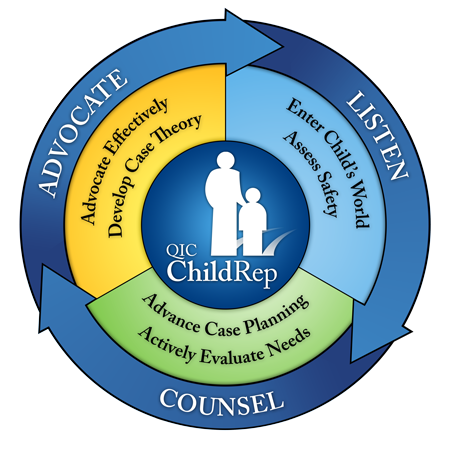Best Practice Model Six Core Skills
The Six Core Skills is an organizing structure that we hope communicates the QIC Model in a clear and cogent way. We broke down each element of the QIC Model to specific lawyer behaviors required to fulfill it and from that identified curriculum goals and objectives. The framing of the Six Core Skills and the QIC Training reflects the realities of adult learning styles and the practicality of how much time attorneys would have available for the training.
We tried to make the training memorable and easy to absorb. We want to maximize the chances that the training would be deeply internalized by the trainees so that it resulted not only in knowledge acquisition but also a change in the lawyer behaviors. The application of the Six Core Skills is not linear. The desired attitudes, behaviors and skills are required from the beginning to the end of the court process; they are manifest in the lawyer’s many interactions with the child and others participants in the child welfare process. Connecting each element of the QIC Model to specific lawyer knowledge and behavior, also informed the design of our research instruments and the articulation of the Six Core Skills. The QIC Training makes two critical assumptions. First, that the attorneys knew the basics of their state law and procedure, and second, that they had fundamental trial practice skills.
It needs to be emphasized that the QIC Best Practice Model is intended for lawyer representation of children and is not intended for CASAs or lay guardians ad litem as a substitute for lawyers. We assume that lawyer knowledge of the law, procedure and practice are required to implement the QIC approach.
The Six Core Skills add the QIC Best Practice knowledge and clinical skills to the basic lawyer expertise required to be a successful legal representative for an alleged maltreated child. The figure below summarizes the Six Core Skills along with the graphic used throughout the training and elsewhere as a mnemonic to remind lawyers of its components. The graphic emphasizes three dimensions of advocacy – listen, counsel and advocate and places the Six Core Skills in that context.

- Enter the Child's World: Engage with the child, learn their needs, guide them, counsel them and advocate for their needs while accommodating their stated interests consistent with state law.
- Assess child safety and protect the child but without over-reacting. “Remove the danger, not the child”, whenever that can be done consistent with child safety. Distinguish between case plan and safety plan.
- Actively Evaluate Needs: Facilitate an appropriate assessment of the needs of the child and his/her family. Diagnose the problem.
- Advance Case Planning: Facilitate development of an appropriate case plan.
- Develop Case Theory: Develop an active and forward looking theory of the case. What is going on here? Adopt, and maybe rule-out, alternative and tentative theories of the case. Provides force and direction to the advocacy. (Drive the bus.).
- Advocate Effectively: Use advocacy corollaries in meeting a child's needs that stress problem-solving and non-adversarial approaches - but which include traditional adversarial modes when appropriate.
For Training Materials on the Six Core Skills, click here.